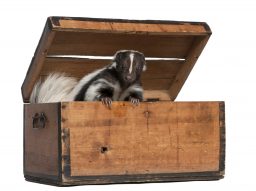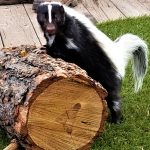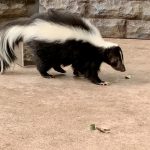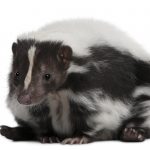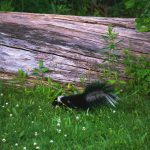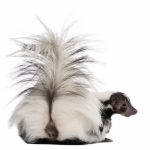Skunks do not hibernate or migrate in colder weather. Their natural habitat ranges from snowy Canada to the deserts of Mexico. They adapt to wherever they are.
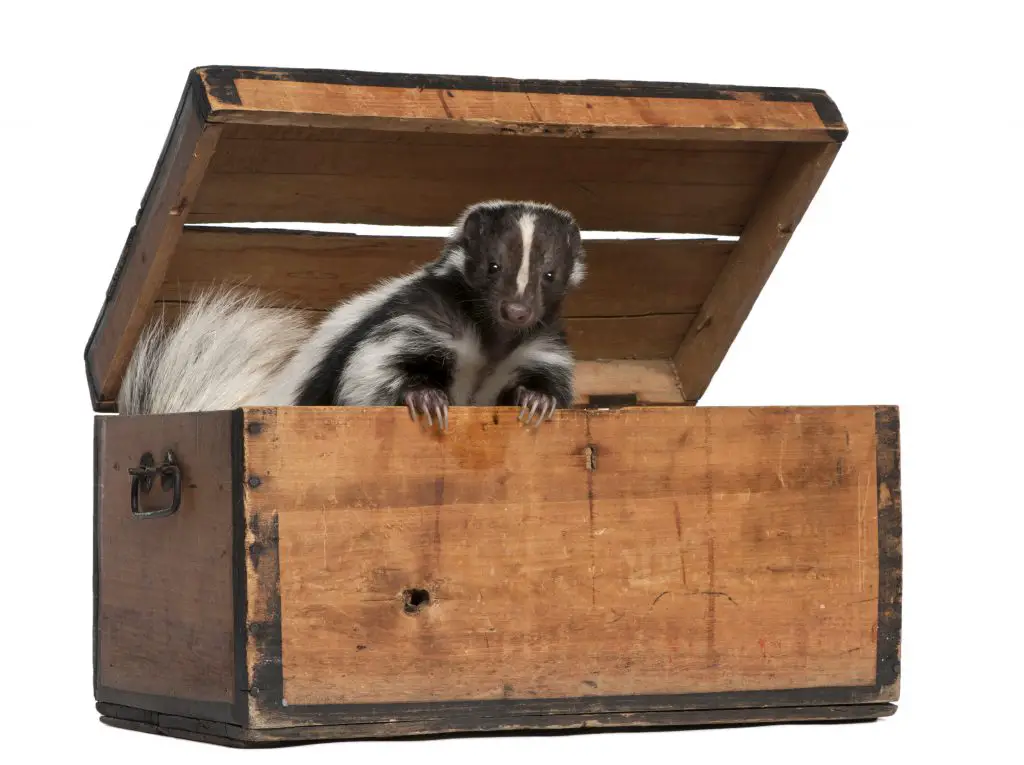
Do Skunks Hibernate In Winter?
There are very few mammals who truly hibernate – and the skunk isn’t one of them. Like squirrels and bears – they just den up for the colder month underground. Snug inside a well-tended burrow, they wait out the coldest months when their food is hard to find.
Hibernation is a very technical biological activity that involves many metabolic changes. These periods of dormancy include lowered heart rate and reduced kidney function in particular – but actually, entail the animal being completely motionless. If you disturb a hibernating ground squirrel, for example, it won’t move – you can reach in and just pick it up (but please don’t). If you disturb a denning skunk (and again, please don’t) it will be wide awake in an instant and most likely spray you in the face for your rudeness.
Skunks in the colder climes – such as the Striped Skunk (Mephitis mephitis) living in the northern states and in southern Canada – can and will lower their body temperature to help conserve energy while denning. Just like bears in the same range – they live off their fat reserves almost the whole time (early winter to late spring) hardly eating a thing. Skunks here can lose over 50% of their body weight during this time.
How Far Do Skunks Migrate?
They don’t. Skunks have adapted to live in climates from the snowy mountains of Canada to the flat, rocky deserts of Mexico – they won’t be migrating anywhere. It takes thousands of generations to adapt to a habitat – and each species and subspecies of skunk has done just that. If you have evolved to live in the snow – why would you migrate away when it snows?
Similarly – if you have evolved to live and feed in a rocky canyon in Alberta; along the sandy coast in Baja; or on the windswept plains of Patagonia – why would you go anywhere else? The fact that there are 10 species and several dozen sub-species of skunk the full length of the Americas, shows that they did their migrating early on – and decided to set up home at every point along the way.
Unlike true migration where the animals or birds don’t live along the journey route – either living in one place or the other – skunks have been so successful at every step of the way – that they have colonised habitats far and wide. It is only in the very coldest parts or wettest parts of the continent that they can’t yet survive in, but woodland, mountains, coastlines, urban, farmland or prairie – they have it covered.
Do Skunks Adapt To Different Climates?
With such a wide-ranging habitat between them, the skunk family have managed to adapt to almost every type of landscape.
In North America, it is only the very coldest places that don’t have resident skunks – the 50 contiguous states all have skunks (Striped, 2 x Spotted, Hog-nosed and Hooded) – but no skunks in Alaska or Hawaii unfortunately.
Central America has the same 5 plus and additional three – the Pygmy Spotted, Striped Hog-nosed and Southern Spotted – it seems that the dry warmer climate there is very popular.
South America is patchy with only 3 endemic skunk species whose ranges don’t overlap at all and who all avoid tropical rainforests (well, you can’t dig underground in the rainforest): Humboldt, Molina’s, and Striped Hog-nosed.
Do Skunks Hibernate or Migrate Just Like Wolves?
Understanding wolves’ hibernation and migration patterns can help shed light on the common question of whether skunks exhibit similar behavior. While wolves are known to migrate to seek food and breeding opportunities, skunks, on the other hand, do not hibernate or migrate extensively. These distinct patterns make the two species differ in their seasonal behaviors.
How Far Do Skunks Travel?
Due to their dietary requirements – skunks often wander up to around a mile or less a day looking for food. They have a basic home range of around 4 square miles depending on the habitat type and the season.
Many skunks live and feed in the same areas when food is in good supply. They will all use the same dens too when needed – often sharing them in very cold weather to stay warm – and in very hot weather to stay cool. Only moms with young don’t share dens with anyone.
In places with a noticeable change in climate over the year – skunks often specialize in one food type in warmer weather – say insects, and in colder weather, they seek out another. So say, moving from mountains to the plains and back. This way – they get to take advantage of the best seasonal foodstuffs on offer each time.

